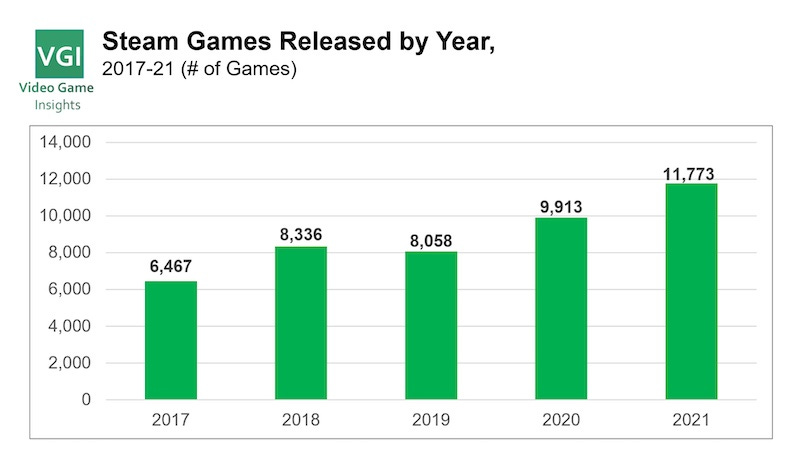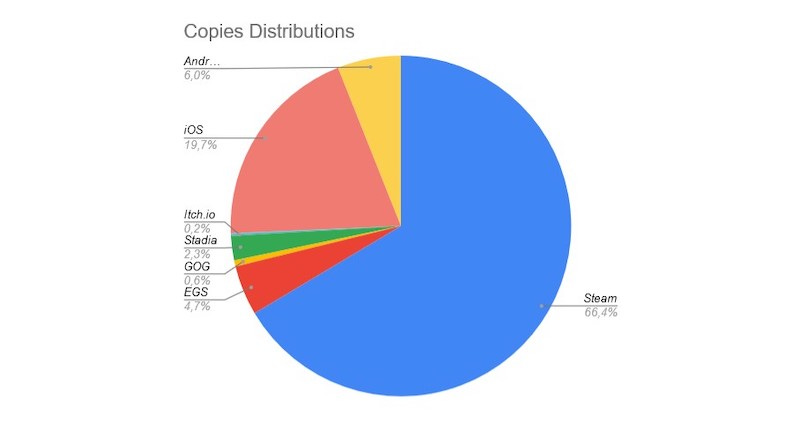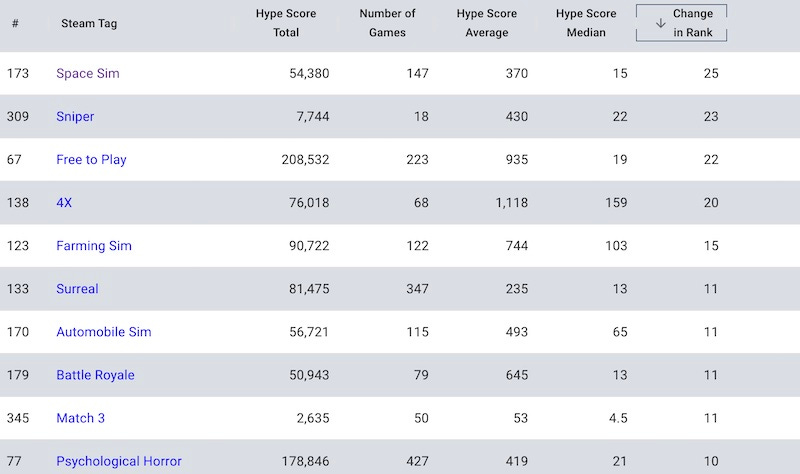When should you announce your game for max discovery?
Publikováno: 7.2.2022
Wait.. who's Max Discovery and why does he care?
[The GameDiscoverCo game discovery newsletter is written by ‘how people find your game’ expert & GameDiscoverCo founder Simon Carless, and is a regular look at how people discover and buy video games in the 2020s.]
Good Monday to you, folks. I’m afraid I’ve just heard that Earth is to be demolished due to an intergalactic highway construction project. So it’ll be pointless continuing this newsletter any further. Perhaps we should all just go for a pint instead?
…oh, right, that’s fictional. In reality, we’re slowly cooking ourselves, and all you studios should go sign up for Playing 4 The Planet with the UN and make concrete business changes before it’s too late. In the meantime, here’s the (back on!) newsletter..
[REMINDER - we have 22% off our GameDiscoverCo Plus subscriptions for the next 22 days, with perks including an exclusive weekly Plus newsletter, an info-filled Discord to hang with peers, a data-exportable Steam Hype back-end, a game discovery eBook, lots more.]
When do you start talking about your video game?
Whenever somebody asks when you should tell everyone about your video game, hopeless rubes like me often yell: ‘Now, dammit! Now! Even if the game is the glint in the milkman’s eye, do it now!’ To some extent, that’s helpful, because many devs have a habit of prevaricating on announcing or marketing their game until it’s too late.
But veteran dev Aaron San Filippo (Race The Sun) had a very good Twitter thread the other week about this very subject, in part related to his upcoming Star Fox-ish title Whisker Squadron, and titled: “For the love of god, please don't announce your game and put a Steam page up as soon as you commit to development.”
The whole thread has more detail, but here’s some of the key points: “I've come to believe pretty strongly that while it's best to have a Steam page up for a long time, it's almost never a good idea to announce a game and put up a page for a game that looks unpolished. Here are a few reasons:
1. While the algorithm doesn't "punish" games that don't do well at launch, it *does* reward games that are hot at any given time. Games w/ a big influx of traffic get shown to more users organically in a variety of places on Steam. Quiet announcement = no free visibility.
2. First impressions matter. If potential players, press, platforms, influencers see a mediocre-looking version of your game, some of them WILL decide they're not interested (See: First impression bias). You're creating an uphill battle to change their minds.
3. Launching a Steam page gives you an influx of initial traffic as the game shows up in people's queues etc. and Steam literally gives people tools to tell it they're not interested. You want to convert as many of those as possible because some of them won't see it again!
4. There is nothing more demoralizing than launching a Steam page for a game and then watching it get 0-5 wishlists per day, knowing you need tens of thousands to have any shot at sustainable success. Being demoralized is not a good place to be in the marathon of shipping a game.”
And, as Aaron concludes: “The thing is, this is a paradox: You want your Steam page up as early as possible, but want it to look as polished as possible. The solution here, I think, is to invest heavily in your game's presentation, early in development. This is a big shift for some of us, especially me!
For my next game, I'll invest more heavily in key art, and a vertical slice that has enough polished content that I can make some gameplay footage and screenshots that look potentially shippable. A Steam page won't go live before that.”
This is very much correct from my perspective. In fact, I’ve been working with more and more devs and publishers who are thinking about how to get a ‘real-looking’ trailer for their game early in development, to start the hype.
Why? Well, we talked a bit back in 2020 about how to find player ‘evangelists’ for your game. And pretty often, they need to be able to envisage the end of the process to get excited about your work-in-progress updates. So putting your best foot forward early is vital.
We’re also wondering how the rise of game subscription services will change this, since ‘being discovered on the platform when you already own the game’ is a different caboodle than ‘need to see, wishlist then buy the game’. We’ll have to see - it’s complex.
[BTW, I think Whisker Squadron is a great game for subscription services. Why? It’s an interesting, accessible, but relatively rarely tackled subgenre. This makes it more difficult to sell based on ‘similar Steam hit games’, but a pleasant surprise for anyone getting it in a sub.]
Steam trends in 2021: what does the graph say?

The crew over at VGInsights were kind enough to put together a large-scale analysis of multi-year Steam trends and how 2021 fit in. And they know I’m a sucker for bar charts, so I can only presume it was made especially for myself, and myself only.
Anyhow, feel free to read the entire thing in your own time. I do think that some of this stuff defies easy categorization, although I’m impressed in the manual work they’re doing in trying to subdivide ‘AAA’ and ‘indie’ games. But here’s some takeaways I had from it:
There are more games, but also more games trying to make money: you all know that more and more titles are being released on Steam (see above chart). But it’s also great to see games subdivided by price. Turns out 23.4% of the 11,700 titles in 2021 are charging at least $10, compared to 21% of 9,900 games in 2020. So that’s about 2,700 ‘trying to make premium $’ games in 2021 - around 8 per day, and more than 600 up on the year before.
COVID had a temporary effect on AAA studios, but indie growth churned on: this makes a lot of sense if you think of how large in-person studios operate, vs. relatively small, often natively remote indies. Thus, VGInsights has a believable graph (below) showing that there was a slump and then backlog launch in the AAA space in 2020-2021, and no such thing for the mass of indie titles:
It’s difficult to separate out fun/hobby Steam projects from professional ones: VGInsights mentions that Steam consists of “mostly hobby projects and shovelware”, and “27% of the games released in 2021 have only sold under 100 units. Only about 8% of the games released sold 10,000 units or more.” Maybe that’s fine if you’re that 8%. But my biggest question nowadays: if you’re not a hobby project, how do you not get lost in a sea of older high-quality games and new - sometimes fairly good - hobby projects?
The game discovery news round-up..
Well, that’s a whole bunch of water under the bridge, or coins in the fountain, or what have you. And before we finish up for the day, a lot of good video game industry news, if you like platforms and discovery and numbers. And we love all three of those things:
First up, Broken Arms’ Yves Hohler put up a ‘copies sold’ graph (above) for PC & mobile winemaking sim Hundred Days. Notable things - Epic Games Store sales were 6.7% of Steam’s, probably aided by $10 coupon sales. And iOS has a decent % of total sales - but likely only single-digit thousands still, and at $6, vs. $25 for the PC version. Very interesting!
A couple of of hours ago, Valve just allowed three YouTube outlets to go out with limited Steam Deck previews based around the hardware - so there’s in-depth new videos from Linus Tech Tips, The Phawx, and Gamers Nexus which are worth checking out. Amusing/unfair YouTube comment: “Excited to see more but geez how many layers of embargo can Valve have.”
We didn’t cover the original Jeff Vogel blog post about there being ‘too many games’, but Dan Boland’s reply is a good riposte: “Independent game development is a massive field, and covers modding, mapping, free web games, fan games, FOSS games, game jams, doujin markets, cheeky summer projects between jobs or school… it takes a strange tunnel vision, probably one built by whatever it means to be a “businessman” in the indie space, to think the folk sat in a corner wanting to lighten the world a little bit have anything to do with it.”
You might have seen some reports that Google Stadia is being further sidelined in favor of the Google Stream white-label streaming service, which is being used by Peloton & others. Not sure if anything earthshattering changed here, and Stadia is still a thing, but a gradual backgrounding is taking place. And one interesting stat: “Google Stadia also had around 750,000 monthly active users in 2020… reportedly miss[ing] a target of 1 million monthly active users.”
Is Apple going to charge a 27% cut on $ taken via third-party payments for the iOS App Store (vs. a normal 30%), and then ask for dev payment via invoice monthly? Well, it’s what they are proposing in the Netherlands for a settlement around dating apps, with a mandatory disclaimer: “This app does not support the App Store’s private and secure payment system.” Will this be the eventual Apple vs. Epic ‘fix’?
Nintendo’s results hit just after last Wednesday’s newsletter, but for anybody who missed it, the Switch is now at 103.5 million units, beating the original Wii, & some first-party Nintendo game shipment #s are impressive (Metroid Dread: 2.74 million; Mario Party: 5.34 million, Pokémon Brilliant Diamond & Shining Pearl: 13.97 million.) There were 98 million ‘playing’ Switch users, and 29 million-selling (shipping?) games in the last fiscal year - but 22 of them are made by Nintendo, haha.
Guess it’s true that early 2022 is pretty busy on the AAA game release side of things - Polygon tries to get to grips with why, also claiming: “The release calendar has been changing gradually over the past decade, and this new trend of early-in-the-year big releases might become permanent. While November used to be the de-facto busy season, there are now two times of year that stand out: October to November and February to March.”
Meta’s content ecosystem director Chris Pruett made extra comments on the announcement of $1 billion in gross Quest store VR game sales: “Details are more important. Dev success on Quest is very broad: 8 titles have made over $20M in gross revenue… 14 titles > $10M, 17 titles > $5M. More than 120 titles have generated revenue in the millions - that’s 2x more than the figure we shared last year.”
Microlinks: PlutoSphere allows you to cloud-stream PC VR games to Quest without using your own PC; is the physical-game heavy Nintendo seeing limited digital growth for its own games?; StreamHatchet has a new 2021 game streaming report, as extracted by Game Dev Reports.
Finally, you Plus crew saw this in last Friday’s premium newsletter, but wanted to mention to all that we rolled out a new interactive data tool for our paid subscribers, analyzing the hottest Steam tags for unreleased games.
We’ll be refining it over time and hopefully picking up long-term trends. But here’s an interesting snapshot as an example. Here’s the tags ‘trending’ over the last 14 days for in-development Steam titles (and yes, you can click on a tag to see all the games in it):
[We’re GameDiscoverCo, a new agency based around one simple issue: how do players find, buy and enjoy your premium PC or console game? We run the newsletter you’re reading, and provide consulting services for publishers, funds, and other smart game industry folks.]



